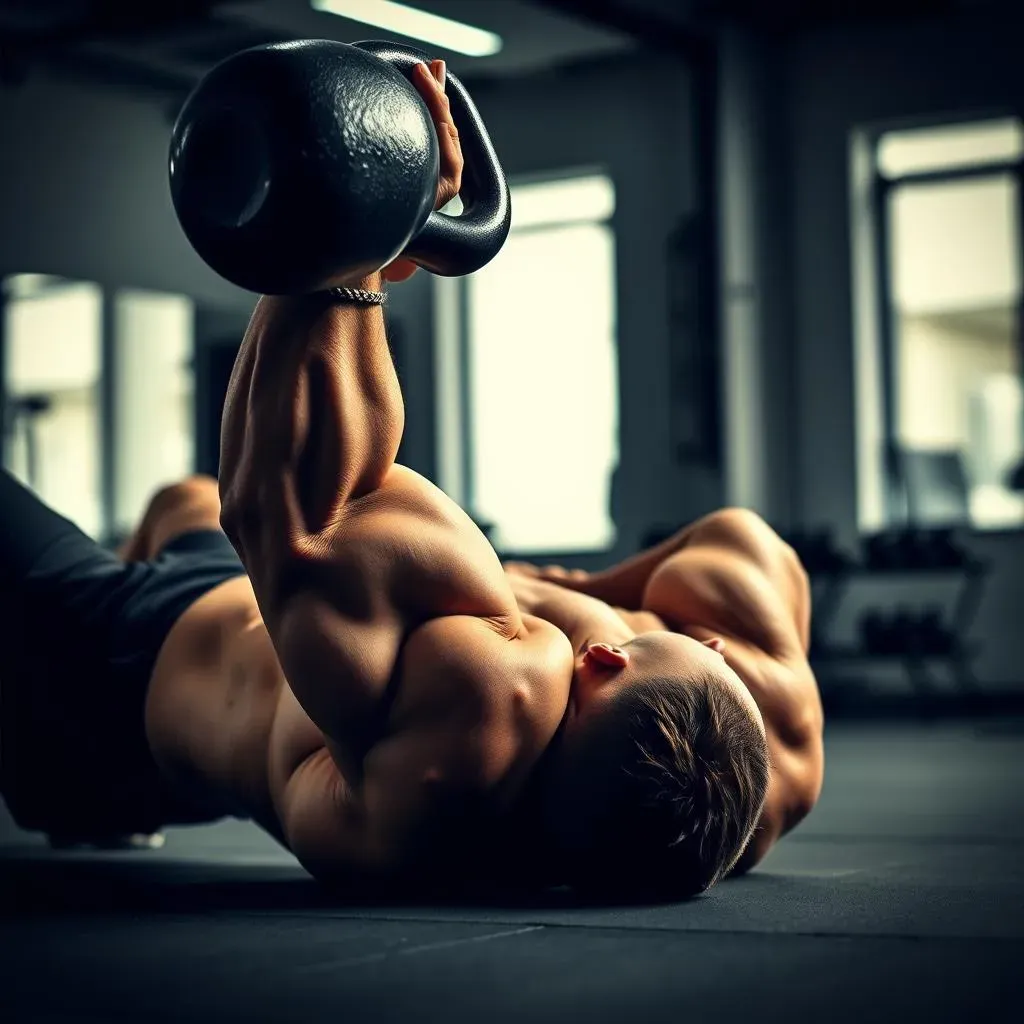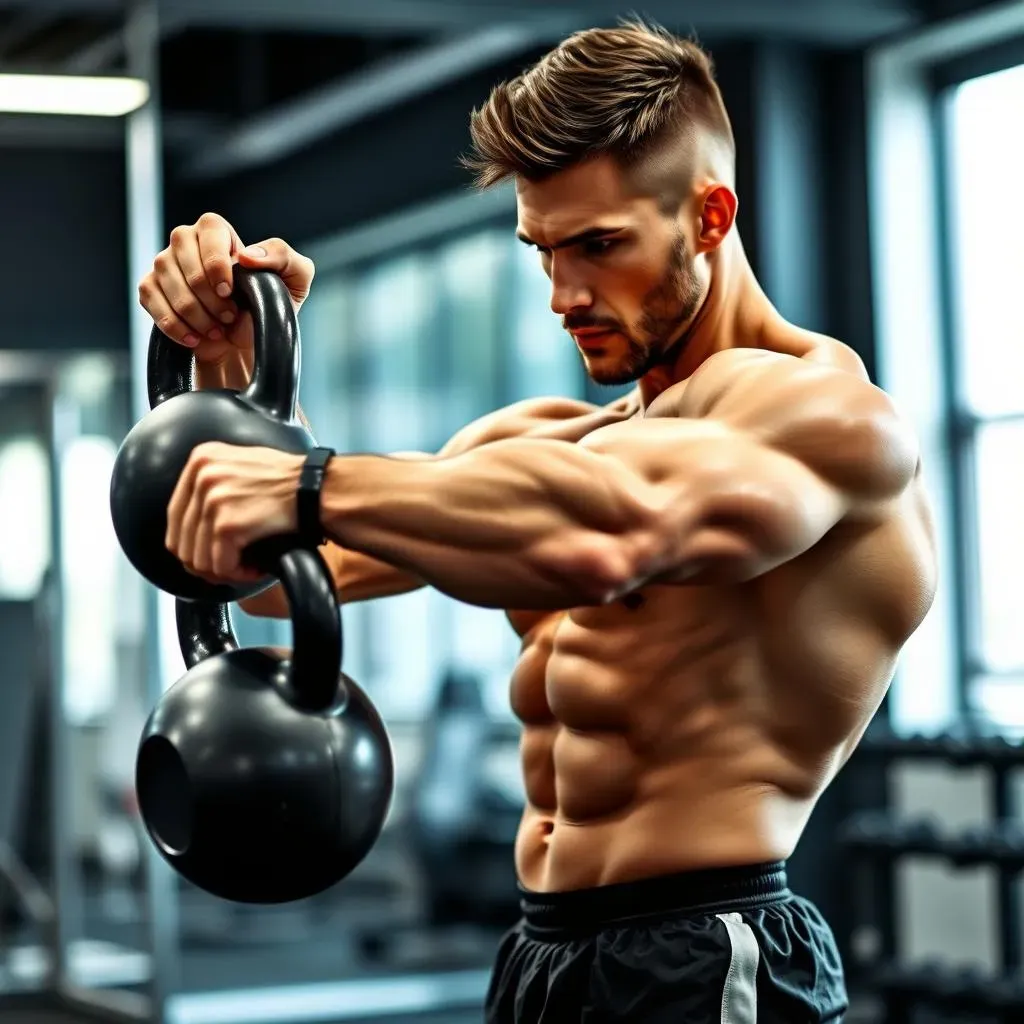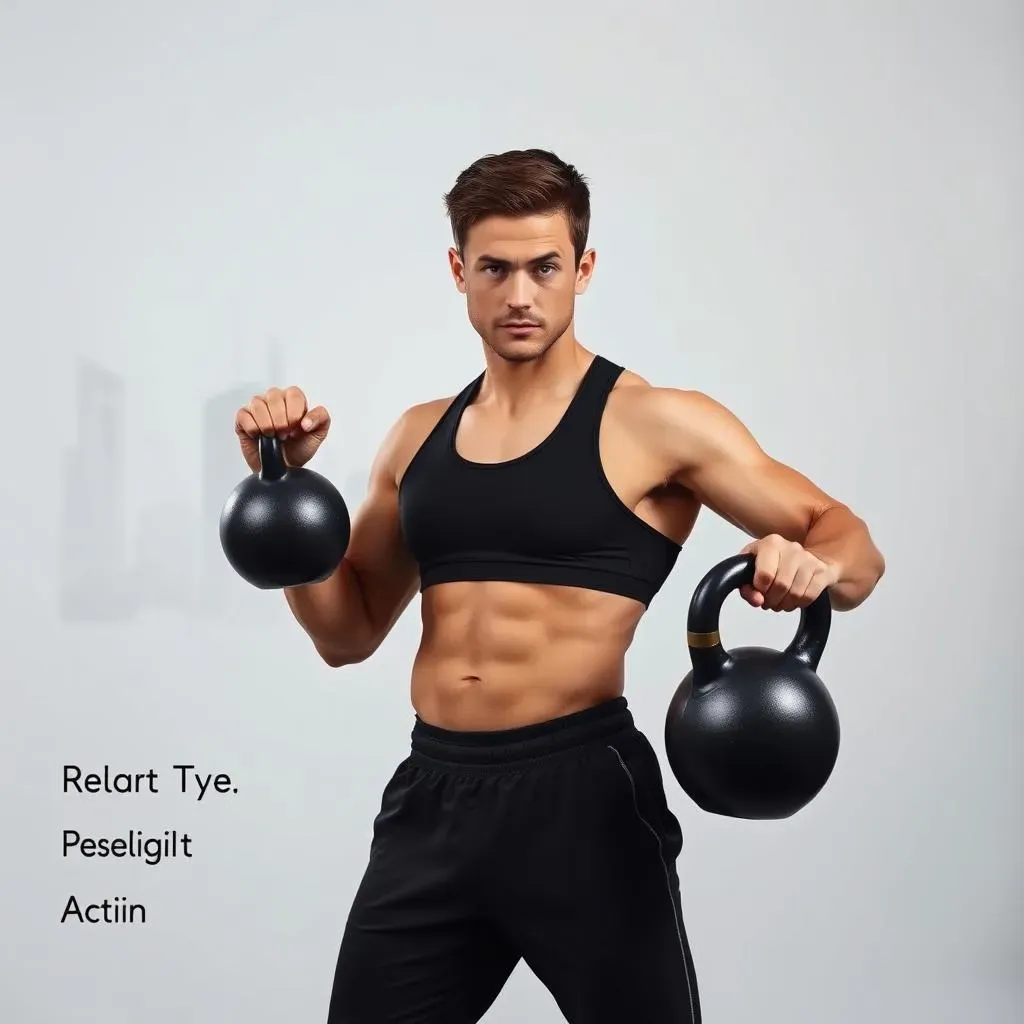Table of Contents
Want boulder shoulders and the strength to match? You've landed in the right spot. This isn't just about aesthetics; it's about building resilient, functional shoulders that can handle anything life throws your way. But let's be real, the shoulder joint is a complex beast, prone to injury if you don't treat it with respect. That's where kettlebells come in. This guide dives deep into the world of kettlebell shoulder exercise, offering a roadmap to building stronger, more stable shoulders without the risks. We'll break down the essential anatomy, highlight the top exercises for both strength and stability, and even craft sample workouts tailored to your specific goals. So, whether you're a seasoned kettlebell enthusiast or a complete newbie, get ready to unlock the power of kettlebells and transform your shoulder game. Prepare to learn how to progress safely, avoid common mistakes, and ultimately, achieve the shoulder strength and mobility you've always wanted.
Understanding Shoulder Anatomy for Kettlebell Training

Understanding Shoulder Anatomy for Kettlebell Training
The Shoulder Complex: More Than Just a Joint
Alright, let's talk shoulders. But before you start slinging kettlebells around, it's crucial to understand what's going on under the hood. Your shoulder isn't just one joint; it's a complex network of bones, muscles, ligaments, and tendons all working together. Think of it as a finely tuned orchestra – if one instrument is out of sync, the whole performance suffers. We're talking about the glenohumeral joint (where your arm bone meets your shoulder blade), the acromioclavicular joint (where your collarbone meets your shoulder blade), the sternoclavicular joint (where your collarbone meets your sternum), and the scapulothoracic joint (where your shoulder blade glides along your ribcage). Each plays a vital role in shoulder movement and stability.
And what about the muscles? You've got your rotator cuff muscles (supraspinatus, infraspinatus, teres minor, and subscapularis) responsible for stabilizing the shoulder and controlling rotation. Then there are the bigger players like the deltoids (for overall shoulder movement), trapezius (for shoulder blade movement), and latissimus dorsi (for pulling motions). Understanding how these muscles work together is key to designing a safe and effective kettlebell shoulder exercise program. Ignoring this intricate anatomy is like trying to build a house on a shaky foundation – it might look good for a while, but it's bound to crumble eventually.
Why Anatomy Matters for Kettlebell Training
So, why all this anatomy talk? Because kettlebell training, while incredibly effective, can also be demanding on the shoulders. Unlike machine exercises that isolate specific muscles, kettlebell movements often involve multiple joints and muscle groups working in coordination. This means your shoulder needs to be stable, mobile, and strong enough to handle the load. Without a solid understanding of shoulder anatomy, you're essentially flying blind, increasing your risk of injury.
For example, improper form during a kettlebell swing can place excessive stress on the rotator cuff tendons, leading to tendinitis or even tears. Similarly, attempting overhead presses with insufficient shoulder mobility can cause impingement, where tendons get pinched between bones. By understanding the biomechanics of each exercise and how it affects the shoulder joint, you can make informed decisions about exercise selection, weight progression, and technique adjustments. This knowledge empowers you to train smarter, not harder, and ultimately achieve your shoulder goals without ending up on the sidelines.
Top 5 Kettlebell Exercises for Shoulder Strength and Stability

Top 5 Kettlebell Exercises for Shoulder Strength and Stability
Kettlebell Arm Bar: Unlock Shoulder Mobility
Alright, let's kick things off with an exercise that's all about shoulder mobility and stability: the Kettlebell Arm Bar. This isn't about brute strength; it's about controlled movement and opening up your shoulder joint. Lie on your back, holding a kettlebell in one hand, arm extended towards the ceiling. Then, slowly roll onto the opposite side, keeping your eyes on the kettlebell. You'll feel a stretch in your chest and shoulder. The key here is to move slowly and deliberately, focusing on your breath and maintaining a stable shoulder. This exercise is fantastic for improving shoulder range of motion and prepping your shoulders for heavier lifts.
Think of the Kettlebell Arm Bar as a "reset" button for your shoulder. It helps to realign the joint, improve proprioception (your body's awareness of its position in space), and reduce muscle imbalances. It's also a great way to identify any limitations in your shoulder mobility. If you find it difficult to roll onto your side or keep your arm straight, it's a sign that you need to address those restrictions before progressing to more challenging exercises. Don't rush it; start with a light weight and gradually increase the load as your mobility improves.
Here's a quick guide:
- Lie on your back, kettlebell in one hand, arm extended.
- Roll onto the opposite side, keeping your eyes on the bell.
- Hold the stretch for a few breaths, then slowly return to the starting position.
- Repeat on the other side.
Kettlebell Bottoms-Up Carry: Stability is Key
Next up, we've got the Kettlebell Bottoms-Up Carry. This exercise is all about grip strength, shoulder stability, and focus. Holding a kettlebell upside down (bottom up) forces your shoulder muscles to work overtime to stabilize the weight. Start with a lighter kettlebell, as this exercise is deceptively challenging. Focus on keeping your wrist straight and your shoulder packed (imagine squeezing your shoulder blade down and back). Walk slowly and deliberately, maintaining a tall posture and engaging your core. You'll quickly feel your shoulder muscles firing up!
The Bottoms-Up Carry is more than just a shoulder exercise; it's a full-body challenge that improves your posture, core stability, and mental focus. The unstable nature of the kettlebell forces you to pay attention to every detail of your movement, improving your overall body awareness. Plus, it's a fantastic way to build grip strength, which is essential for many other kettlebell exercises. Don't be surprised if your forearms are burning after just a few steps – that's a sign that you're working hard! As you get stronger, you can increase the weight or the distance you carry the kettlebell.
Here's a quick guide:
- Hold a kettlebell upside down (bottom up) in one hand.
- Keep your wrist straight and your shoulder packed.
- Walk slowly and deliberately, maintaining a tall posture.
- Engage your core and focus on stabilizing the weight.
Creating Kettlebell Shoulder Workouts for Different Goals

Creating Kettlebell Shoulder Workouts for Different Goals
Defining Your Shoulder Goals
Alright, so you're ready to build a kettlebell shoulder exercise program, but where do you even start? First things first, you gotta figure out what you're trying to achieve. Are you looking to build massive deltoids, improve shoulder stability for other sports, rehab a nagging injury, or just generally feel more robust? Your goals will dictate the exercises you choose, the sets and reps you perform, and the overall structure of your workouts. Be honest with yourself and set realistic expectations. Rome wasn't built in a day, and neither are impressive shoulders.
For example, if your primary goal is hypertrophy (muscle growth), you'll want to focus on exercises that target all three heads of the deltoid (anterior, lateral, and posterior) with moderate weight and higher reps (8-12). On the other hand, if you're an athlete looking to improve shoulder stability for throwing or swinging, you'll want to incorporate exercises that challenge your rotator cuff muscles and improve proprioception, using lighter weights and higher reps (15-20). And if you're rehabbing an injury, it's crucial to work with a qualified healthcare professional to design a program that's tailored to your specific needs and limitations. Remember, there's no one-size-fits-all approach to kettlebell shoulder training.
Sample Kettlebell Shoulder Workouts
Now that you've got your goals dialed in, let's talk about putting together some sample workouts. Here are a few examples to get you started, but remember to adjust them based on your individual needs and experience level.
Workout 1: Shoulder Strength and Size
- Kettlebell Clean and Press: 3 sets of 8-12 reps per side
- Kettlebell Front Raise: 3 sets of 10-15 reps
- Kettlebell Lateral Raise: 3 sets of 10-15 reps
- Kettlebell Renegade Row: 3 sets of 8-12 reps per side
- Kettlebell Face Pulls: 3 sets of 15-20 reps
Workout 2: Shoulder Stability and Mobility
- Kettlebell Arm Bar: 3 sets of 30-60 seconds per side
- Kettlebell Bottoms-Up Carry: 3 sets of 20-30 yards per side
- Kettlebell Turkish Get-Up: 3 sets of 1-3 reps per side
- Kettlebell Windmill: 3 sets of 5-8 reps per side
- Kettlebell Halo: 3 sets of 10-15 reps
Workout 3: Shoulder Rehab (Consult with a professional)
- Kettlebell Scapular Retraction: 3 sets of 15-20 reps
- Kettlebell External Rotation: 3 sets of 15-20 reps
- Kettlebell Farmer Carry: 3 sets of 20-30 yards
- Kettlebell Y-Raise: 3 sets of 10-15 reps
- Kettlebell I-Raise: 3 sets of 10-15 reps
Remember to warm up properly before each workout and cool down afterwards. And don't be afraid to experiment with different exercises and rep ranges to find what works best for you. The most important thing is to listen to your body and avoid pushing yourself too hard, especially when you're just starting out.
Progressing Safely with Kettlebell Shoulder Exercise

Progressing Safely with Kettlebell Shoulder Exercise
Master the Fundamentals First
Before you even think about snatching heavy kettlebells overhead, make sure you've nailed the fundamentals. We're talking about mastering basic kettlebell movements like the deadlift, swing, clean, and goblet squat. These exercises build a solid foundation of strength and stability throughout your entire body, including your shoulders. Trying to progress too quickly without this foundation is like building a skyscraper on quicksand – it's just a matter of time before things start to crumble. Focus on proper form and technique, and gradually increase the weight as you get stronger. Don't be afraid to spend weeks or even months perfecting these fundamental movements before moving on to more advanced exercises. Your shoulders will thank you for it.
Think of these fundamental movements as prerequisites for more advanced kettlebell shoulder exercises. They teach you how to properly engage your core, stabilize your spine, and control your bodyweight, all of which are essential for protecting your shoulders from injury. Plus, they build the overall strength and conditioning you'll need to handle heavier loads and more complex movements. So, before you start chasing those Instagram-worthy kettlebell flows, make sure you've got the basics down pat.
Listen to Your Body and Respect Pain
This might sound obvious, but it's worth repeating: listen to your body and respect pain. Kettlebell training can be intense, and it's easy to get caught up in the excitement and push yourself too hard. But if you start to feel any sharp or persistent pain in your shoulder, stop immediately and assess the situation. Don't try to "push through" the pain, as this can often lead to more serious injuries. Instead, back off the weight, modify the exercise, or take a break altogether. It's always better to err on the side of caution when it comes to your shoulders.
Learning to differentiate between "good" pain (muscle soreness) and "bad" pain (joint pain) is crucial for safe and effective kettlebell training. Muscle soreness is a normal part of the training process and usually subsides within a day or two. Joint pain, on the other hand, is a sign that something is wrong and needs to be addressed. If you're unsure whether the pain you're feeling is "good" or "bad," consult with a qualified healthcare professional or a certified kettlebell instructor. They can help you identify the source of the pain and develop a plan to address it.
Pain Type | Description | Action |
|---|---|---|
Muscle Soreness | Dull, achy pain in the muscles, usually after a workout. | Rest, light stretching, and hydration. |
Joint Pain | Sharp, persistent pain in the joints, often accompanied by swelling or stiffness. | Stop the exercise, rest, and consult with a healthcare professional. |
Progress Gradually and Avoid Ego Lifting
Finally, remember to progress gradually and avoid ego lifting. It's tempting to try to lift the heaviest kettlebell in the gym, but doing so before your body is ready is a recipe for disaster. Instead, focus on gradually increasing the weight, volume, or intensity of your workouts over time. This allows your muscles, tendons, and ligaments to adapt to the stress and become stronger and more resilient. And don't compare yourself to others – everyone progresses at their own pace. Focus on your own journey and celebrate your own accomplishments.
Ego lifting is one of the biggest mistakes you can make in kettlebell training. It's when you prioritize lifting heavy weight over proper form and technique, often to impress others or to satisfy your own ego. This can lead to all sorts of problems, including muscle strains, joint pain, and even serious injuries. So, leave your ego at the door and focus on training smart, not hard. Your shoulders will thank you for it.
Conclusion: Kettlebell Shoulder Exercise – Your Path to Stronger, Healthier Shoulders
So, there you have it: a comprehensive guide to building incredible shoulder strength and stability with kettlebells. Remember, the key is to start slow, focus on proper form, and progressively increase the weight and intensity as you get stronger. Don't rush the process, and always listen to your body. Whether your goal is to improve your overhead press, enhance your athletic performance, or simply bulletproof your shoulders against injury, kettlebell shoulder exercise offers a powerful and effective path. Now go grab that kettlebell and start building the shoulders you've always wanted!